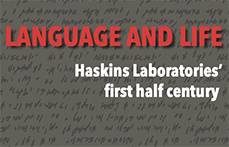Language and Life: Haskins Laboratories’ first half century

The Haskins Press of Haskins Laboratories is pleased to announce the publication of “Language and Life: Haskins Laboratories’ first half century,” by Carol A. Fowler and Donald Shankweiler.
Haskins Laboratories began modestly in 1935 as an experiment. The founder, Caryl Haskins, a young chemist and biologist had just received an inheritance, and he used it to fund a small laboratory to test his contention that the most fertile areas for scientific advancement, both in the applied domain and in the domain of basic research, are borderline areas at the intersection of well-researched disciplines. He and co-founder, physicist Franklin Cooper believed that discovery in science is best promoted in small private organizations that can be more flexible than industrial laboratories, and unlike most university science departments can be interdisciplinary. Through many difficulties the Laboratories survived and grew. This book is about the results of the Haskins experiment during the institution’s first half century. It tells the story of how, following opportunities created by World War ll, the Laboratories achievedbreakthroughs in diverse domains. Breakthroughs in microbiology revealed regulatory mechanisms indispensable for life at the unicellular level in protistans and elucidated intercellular integrative mechanisms common to animal life. Other breakthroughs (discussed in greater detail in the book) concerned the universal, biological capacity of humans for spokenlanguage and drew on competencies from biology, psychology, linguistics, and speech science to “crack the speech code” and later to clarify the relation of speech to writing and reading. Each breakthrough stemmed from opportunities created by practical needs and each led to innovations in basic knowledge. In both domains, findings and theory generated at the Laboratories became a catalyst for research and discussion in the wider scientific community, as the founders had hoped.
Read about the lab’s history and milestone discoveries in pdf or epub format.